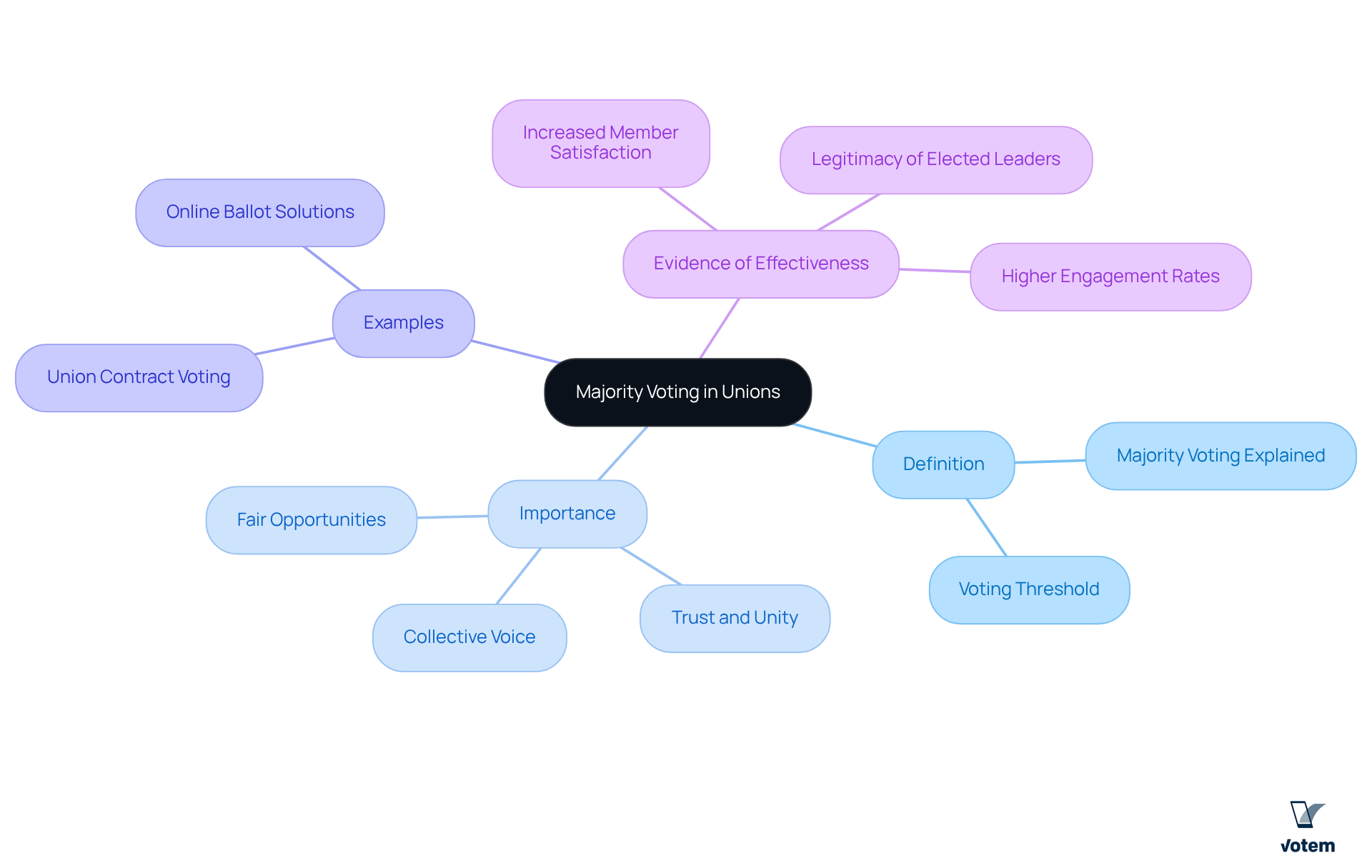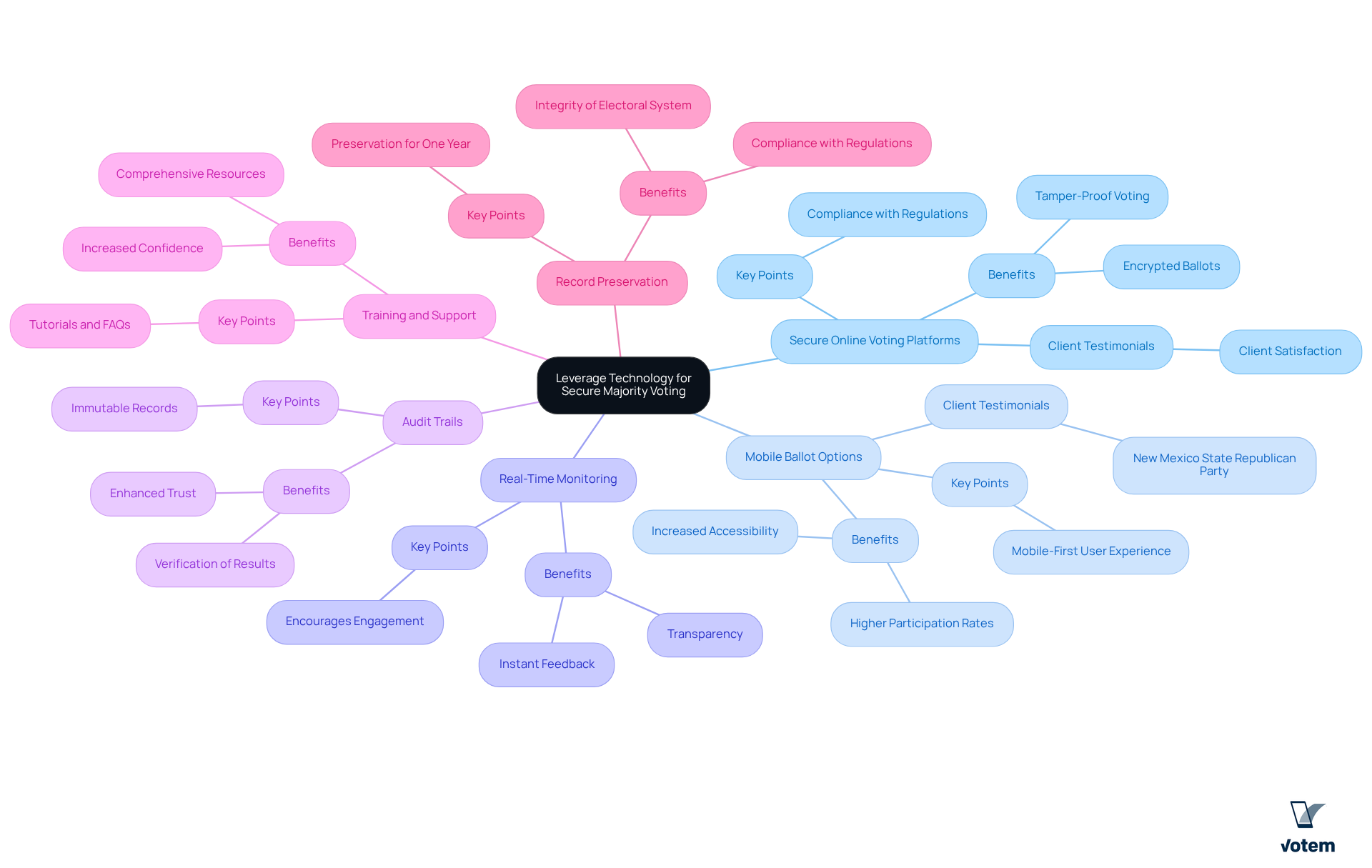Overview
Majority voting is essential in unions, as it guarantees that decisions mirror the collective voice of members, thereby fostering trust and engagement. This mechanism also prevents minority domination in decision-making processes.
Implementing effective majority voting systems, bolstered by technology and clear procedures, not only enhances member satisfaction but also legitimizes the electoral process. Ultimately, this strengthens the union’s position in the broader landscape.
Furthermore, union leadership must recognize that adopting such systems is not merely beneficial but imperative for the health and longevity of the organization.
Introduction
Majority voting serves as a cornerstone of democratic processes within unions, playing a crucial role in shaping leadership, ratifying contracts, and making pivotal decisions. This method not only amplifies the collective voice of members but also fosters a sense of ownership and accountability among participants.
However, as unions navigate the complexities of decision-making, a pressing question emerges: how can leaders effectively implement majority voting to ensure fair representation and enhance member engagement?
Furthermore, exploring the intricacies of various majority voting systems and the integration of technology reveals not only the benefits but also the challenges that union leaders must address to truly empower their constituents.
Define Majority Voting and Its Importance in Unions
The predominant selection method involves majority voting, where the option that secures over half of the votes submitted is chosen. In unions, the method of majority voting is essential for electing leaders, ratifying contracts, and making significant organizational decisions. Its significance lies in ensuring that the collective voice of participants is acknowledged and valued, which promotes a sense of ownership and responsibility. When decisions are made through , trust and unity within the organization are bolstered. Furthermore, majority selection prevents minority groups from dominating the decision-making process, ensuring that all participants have a fair opportunity to influence outcomes.
For instance, when a union votes on a new contract, majority voting ensures that the contract aligns with the preferences of most members, thereby legitimizing the union’s representation of its members’ interests. The company’s innovative online ballot solutions enhance this process by providing greater accessibility for all eligible voters, including military personnel and individuals with disabilities. As Linda McCulloch stated, “Implementing the new, modern system which allowed greater access for all qualified voters from military voters to voters with disabilities was my greatest accomplishment in office.” Evidence indicates that unions utilizing majority voting methods experience higher member satisfaction and engagement, as these systems foster broader support and better representation.
In fact, the organization successfully managed the receipt of 299,000 votes on behalf of the National Radio Hall of Fame, a significant increase from last year’s 126,000 votes received. This collective decision-making approach not only enhances the legitimacy of the electoral process but also mitigates voter dissatisfaction, as elected leaders are perceived to possess a stronger mandate. By utilizing majority voting and the provided solutions, union leaders can significantly enhance participation and satisfaction among constituents, ultimately strengthening the union’s position and efficiency.

Explore Types of Majority Voting Systems
Unions can utilize several types of majority voting, with each system serving distinct purposes. Votem’s innovative online voting solutions can enhance these processes:
- Simple Majority: This is the most prevalent form, where the option with more than half of the votes wins. For instance, in a vote of 100 participants, at least 51 votes are necessary for a decision to pass. The platform streamlines this procedure, guaranteeing accessibility for all participants. Joanne C. from SEIU Local 1021 commended the simplicity of casting ballots for individuals, highlighting the effectiveness of this system.
- Absolute Majority: This system mandates that more than half of the total eligible votes are needed, not just those cast. For example, if there are 200 eligible voters, a decision would require at least 101 votes to pass, even if only 150 members participated in the vote. The platform ensures that choices represent the desire of the majority of the full membership through secure and transparent ballot methods.
- Qualified Majority: This approach may necessitate a higher threshold than a simple majority, such as two-thirds of the votes. Often employed for significant decisions, like constitutional amendments, it ensures that major changes have broad support. Votem’s solutions can simplify these intricate ballot requirements effectively.
- Weighted Voting: In some unions, votes may be weighted based on factors such as membership size or tenure, ensuring that larger groups have a proportionate influence on decisions. Votem’s platform accommodates such diverse methods of participation, enhancing democratic legitimacy by reflecting the varied interests within the union.
Understanding these systems is crucial for union leaders to select the most effective method for their elections. This ensures fair representation and informed decision-making. Prevalent decision-making systems, particularly simple majority and absolute majority voting, have been effectively applied in numerous unions, improving participant satisfaction and confidence in the electoral process. Evidence indicates that organizations utilizing majority voting methods experience higher member engagement, emphasizing the significance of these systems in promoting a democratic atmosphere. With Votem’s commitment to accessible, secure, and , union leaders can confidently navigate these electoral systems.

Implement Majority Voting in Union Elections
To implement majority voting in union elections effectively, union leaders should consider the following steps:
- Establish Clear Rules: Clearly outline the voting procedure, eligibility criteria, and the type of majority needed for decisions. Ensure that all participants are informed of these rules well in advance to foster understanding and compliance.
- Communicate Effectively: Utilize various communication channels to inform members about the election process, candidates, and key issues. Transparency is essential for building trust and encouraging participation.
- Establish a Secure Balloting Mechanism: Choose a selection method that ensures security and confidentiality. Options may include in-person voting, mail-in ballots, or secure online voting platforms such as CastIron, which is designed to meet strict compliance standards. This innovative system has received commendation for improving accessibility for all eligible voters, including military members and people with disabilities, guaranteeing that everyone can participate in the electoral activities. For instance, testimonials from clients highlight Votem’s success in managing large-scale elections, such as handling 299,000 votes for the National Radio Hall of Fame, demonstrating its capability to effectively manage significant voter turnout.
- Conduct the Election: Ensure the election is managed fairly, with impartial oversight. Establishing an election committee can assist in preserving integrity throughout the procedure.
- Count Votes Transparently: After voting concludes, count the votes in a transparent manner, allowing observers to verify the results. Quickly announcing the results is essential for preserving member trust in the electoral system. Votem has successfully delivered over 123,000 votes in previous elections, more than double the turnout of the last election in 2015, showcasing its effectiveness in facilitating voter participation.
- Address Disputes: Establish a clear process for resolving any disputes or challenges to the election results. This guarantees that all participants feel their concerns are recognized and handled suitably.
By adhering to these steps, union leaders can implement majority voting effectively, ensuring that elections are fair, transparent, and truly reflective of the members’ will. This method not only enhances the validity of the electoral system but also aligns with optimal practices that can result in greater success rates in union elections, as demonstrated by the organization’s history of and contentment.

Leverage Technology for Secure Majority Voting
Integrating technology into majority voting processes can significantly enhance both security and participation. Here are several effective strategies to leverage technology:
- Secure Online Voting Platforms: Utilize platforms such as CastIron, which provide secure and compliant online voting solutions. These platforms encrypt ballots, ensuring that votes stay confidential and tamper-proof, thereby fostering trust among participants. As noted by a satisfied client, “Implementing the new, modern system which allowed greater access for all qualified voters from military voters to voters with disabilities was my greatest accomplishment in office.”
- Mobile Ballot Options: Implement mobile-friendly ballot solutions to enhance accessibility, allowing members to cast their votes from anywhere and significantly boosting participation rates. Studies show that mobile-first user experiences can increase turnout by up to three times on launch day. A testimonial from the New Mexico State Republican Party reflects this, stating, “The New Mexico State Republican Party was very pleased with the performance of Votem software. We will be using their services again in May for our State Party’s Quadrennial Election.”
- Real-Time Monitoring: Utilize technology to oversee the election process in real-time, offering transparency and instant feedback on participation levels. This capability reassures members and allows for timely adjustments to encourage greater engagement.
- Audit Trails: Ensure that the voting platform provides an immutable audit trail, which allows for verification of results and enhances trust in the electoral process. The platform includes features such as encrypted ballots and a permanent audit trail, which are essential for upholding compliance with governance standards and protecting against conflicts. A client shared, “Votem helped deliver 123,000 votes, more than double the turnout of the last election in 2015 and the highest number of votes since the election began 30 years ago! Thank you!”
- Training and Support: Provide extensive instruction for participants on how to . This can encompass tutorials, FAQs, and dedicated support hotlines to aid individuals throughout the election procedure, ensuring that everyone can engage confidently. Votem offers comprehensive training materials to ensure all participants are well-prepared to take part in the electoral activities.
- Record Preservation: It is essential to preserve electronic votes and related records for one year, as mandated by regulations. This practice is essential for ensuring compliance and upholding the integrity of the electoral system.
By leveraging these technological advancements, union leaders can create a more secure, efficient, and accessible voting process that encourages member engagement and adheres to the principles of majority voting.

Conclusion
Mastering majority voting is essential for union leaders who seek to cultivate a democratic and participative environment. This method empowers members by ensuring their voices are heard, thereby strengthening the legitimacy of decisions made within the union. By embracing majority voting, unions can foster trust, unity, and overall satisfaction among their constituents, ultimately leading to a more engaged membership.
The article underscores the importance of majority voting in union decision-making, detailing various systems such as simple, absolute, and qualified majorities. Each system serves distinct purposes and can be effectively implemented through clear rules, effective communication, and secure voting mechanisms. Furthermore, the integration of technology, including secure online platforms and mobile voting options, amplifies participation and transparency, addressing modern challenges in the electoral process.
As union leaders consider implementing majority voting, it is crucial to prioritize accessibility and security to ensure all members can engage with confidence. Embracing these practices not only enhances the effectiveness of union governance but also reinforces the core principle of democracy within labor organizations. By leveraging technology and adhering to best practices, unions can navigate the complexities of voting systems, ensuring that every member’s voice contributes to the collective decision-making process.
Frequently Asked Questions
What is majority voting?
Majority voting is a selection method where the option that secures over half of the submitted votes is chosen.
Why is majority voting important in unions?
Majority voting is essential in unions for electing leaders, ratifying contracts, and making significant organizational decisions. It ensures that the collective voice of participants is acknowledged, promoting ownership and responsibility.
How does majority voting promote trust and unity within an organization?
When decisions are made through majority voting, it bolsters trust and unity within the organization by ensuring that all participants have a fair opportunity to influence outcomes, preventing minority groups from dominating the decision-making process.
Can you provide an example of majority voting in action within a union?
An example is when a union votes on a new contract; majority voting ensures that the contract aligns with the preferences of most members, legitimizing the union’s representation of its members’ interests.
How do online ballot solutions enhance the majority voting process?
Innovative online ballot solutions enhance the majority voting process by providing greater accessibility for all eligible voters, including military personnel and individuals with disabilities.
What impact does majority voting have on member satisfaction and engagement in unions?
Evidence indicates that unions utilizing majority voting methods experience higher member satisfaction and engagement, as these systems foster broader support and better representation.
What was a significant achievement related to voting mentioned in the article?
The organization successfully managed to receive 299,000 votes on behalf of the National Radio Hall of Fame, a significant increase from the previous year’s 126,000 votes, highlighting the effectiveness of majority voting.
How does majority voting mitigate voter dissatisfaction?
Majority voting enhances the legitimacy of the electoral process, leading to elected leaders being perceived as having a stronger mandate, which mitigates voter dissatisfaction.
List of Sources
- Define Majority Voting and Its Importance in Unions
- Understanding Plurality vs Majority Voting: Key Differences and Impacts | Online Voting with Votem® (https://votem.com/understanding-plurality-vs-majority-voting-key-differences-and-impacts)
- Understanding Plurality vs Majority Voting for Unions | Online Voting with Votem® (https://votem.com/understanding-plurality-vs-majority-voting-for-unions)
- 16 million workers were unionized in 2024: Millions more want to join unions but couldn’t (https://epi.org/publication/millions-of-workers-millions-of-workers-want-to-join-unions-but-couldnt)
- US union organizing, and unions’ election win rate, is surging, NLRB says (https://reuters.com/legal/litigation/us-union-organizing-unions-election-win-rate-is-surging-nlrb-says-2024-07-17)
- Explore Types of Majority Voting Systems
- Bill to remove Colorado requirement for second vote to unionize passes House committee | Colorado Newsline (https://coloradonewsline.com/2025/03/13/bill-remove-second-vote-unionize-passes)
- Trade Union Elections – ElectionBuddy (https://electionbuddy.com/customers/trade-union)
- Understanding Plurality vs Majority Voting for Unions | Online Voting with Votem® (https://votem.com/understanding-plurality-vs-majority-voting-for-unions)
- NLRB Weakens Secret-Ballot Elections in Union Campaigns, Increasing Unionization Perils (https://klgates.com/NLRB-Weakens-Secret-Ballot-Elections-In-Union-Campaigns-Increasing-Unionization-Perils-8-31-2023)
- Implement Majority Voting in Union Elections
- UAW Statement on Union Election at BlueOval SK – UAW | United Automobile, Aerospace and Agricultural Implement Workers of America (https://uaw.org/uaw-statement-on-union-election-at-blueoval-sk)
- (https://keystoneresearch.org/research_publication/new-data-show-that-americans-support-unions-but-political-and-employer-opposition-stalls-workers-momentum)
- Labor Board Issues New Election Rules and Makes It Easier for Workers to Unionize Without a Vote – Jackson Lewis (https://jacksonlewis.com/insights/labor-board-issues-new-election-rules-and-makes-it-easier-workers-unionize-without-vote)
- Workers want unions, but the latest data point to obstacles in their path: Private-sector unionization rose by more than a quarter million in 2023, while unionization in state and local governments fell (https://epi.org/publication/union-membership-data)
- Leverage Technology for Secure Majority Voting
- Online Voting for Unions (https://polyas.com/unions)
- Online Voting with Votem® | Elections Made Easy (https://votem.com)
- Electing Union Officers Using Remote Electronic Voting Systems (https://dol.gov/agencies/olms/compliance-assistance/tips/remote-electronic-voting-systems)
- 9 Free Online Voting Tools for Engaging Union Members | Online Voting with Votem® (https://votem.com/9-free-online-voting-tools-for-engaging-union-members)
- Best Practices for a Secure Voting Website Poll in Unions | Online Voting with Votem® (https://votem.com/best-practices-for-a-secure-voting-website-poll-in-unions)

